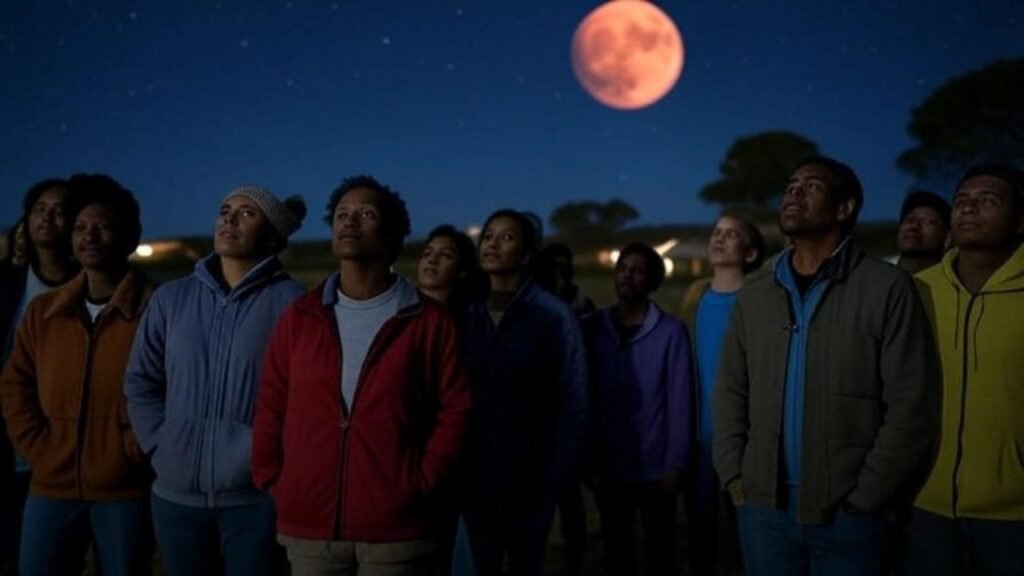Blood Moon Captivates – The recent Blood Moon spectacle captivated skywatchers across South Africa, drawing crowds to open fields, observatories, and rooftops eager to witness the celestial phenomenon. This rare event, a total lunar eclipse where the Moon takes on a reddish hue, occurred under clear skies in major cities like Johannesburg, Cape Town, and Durban, providing an unobstructed view for enthusiasts and amateur astronomers alike. Experts explained that the “blood-red” appearance is caused by sunlight scattering through the Earth’s atmosphere, filtering out blue light and allowing red wavelengths to illuminate the Moon. The event sparked widespread interest on social media, with countless photos and videos shared under hashtags such as #BloodMoon and #LunarEclipse2025. Local astronomy clubs, including those associated with the South African Astronomical Observatory, hosted special viewing sessions and educational talks to help the public understand the science behind this stunning visual experience. Many families and students took advantage of the rare opportunity to observe celestial mechanics firsthand, blending education with awe-inspiring natural beauty.

The Science Behind the Blood Moon
The Blood Moon, scientifically known as a total lunar eclipse, occurs when the Earth positions itself directly between the Sun and the Moon, casting a shadow that envelops the lunar surface. During the eclipse, sunlight passes through Earth’s atmosphere, bending around the planet and filtering out shorter wavelengths while letting the longer red and orange wavelengths reach the Moon. This atmospheric refraction is the reason why the Moon appears reddish rather than disappearing entirely. According to NASA, these lunar eclipses provide unique opportunities for scientific observation, including studies of Earth’s atmosphere and the Moon’s surface. In South Africa, the clear winter skies of September 2025 offered an ideal viewing window, and local astronomers encouraged the public to record the event using telescopes or high-resolution cameras. For students and educators, witnessing the Blood Moon in real-time provided an excellent chance to connect theoretical astronomy lessons with observable phenomena, enhancing interest in space science and astronomy as a career path.
Impact on Skywatching Communities
The Blood Moon created a surge of activity among skywatching communities throughout South Africa. Amateur astronomy societies organized gatherings at parks and observatories, sharing equipment like binoculars and telescopes for optimal viewing experiences. Online communities, such as Astronomy South Africa, documented the event with live streams and commentary, making the phenomenon accessible to those unable to attend in person. The eclipse also inspired creative content, including photography contests and educational videos, further bridging the gap between scientific knowledge and public engagement. For many enthusiasts, this event was not just a visual spectacle but an opportunity to discuss planetary motion, orbital mechanics, and atmospheric science with peers. Meteorological conditions played a critical role, and forecasts provided by the South African Weather Service helped viewers plan the best locations and times for observation, ensuring that the event could be enjoyed safely and without interference from clouds or precipitation.
Cultural and Historical Significance
Beyond the scientific fascination, the Blood Moon holds cultural and historical significance in South Africa and globally. Many indigenous communities have long observed lunar eclipses, interpreting the red Moon as an omen or a symbol within traditional folklore. Historical records show that eclipses have influenced agricultural planning, navigation, and even political events in various cultures. Modern interpretations blend these traditional beliefs with contemporary scientific understanding, offering educational opportunities to discuss the intersection of culture, history, and astronomy. In schools and museums, educators leveraged the Blood Moon to highlight the Moon’s role in timekeeping, calendars, and myths, creating a holistic learning experience that connected natural phenomena to human civilization. Events hosted by SciFest Africa incorporated storytelling sessions alongside scientific demonstrations, allowing audiences of all ages to appreciate the layered significance of this celestial occurrence.
Preparing for Future Lunar Events
The excitement surrounding this Blood Moon has increased awareness and enthusiasm for upcoming lunar events in South Africa. Astronomers recommend marking calendars for partial and total lunar eclipses, meteor showers, and planetary alignments, providing opportunities for continued engagement with space science. Educational institutions and astronomy clubs are increasingly offering workshops and outreach programs to prepare the public for these events, equipping enthusiasts with the knowledge and tools to observe safely. Resources such as Time and Date provide detailed schedules and visibility maps for future eclipses, helping observers plan locations, timings, and equipment requirements. The widespread interest generated by the September 2025 Blood Moon demonstrates the growing importance of astronomy as both an educational tool and a source of community engagement. As skywatchers across South Africa reflect on the stunning visuals of the red Moon, anticipation builds for the next celestial display, inspiring curiosity, scientific inquiry, and a deeper appreciation of the universe.








